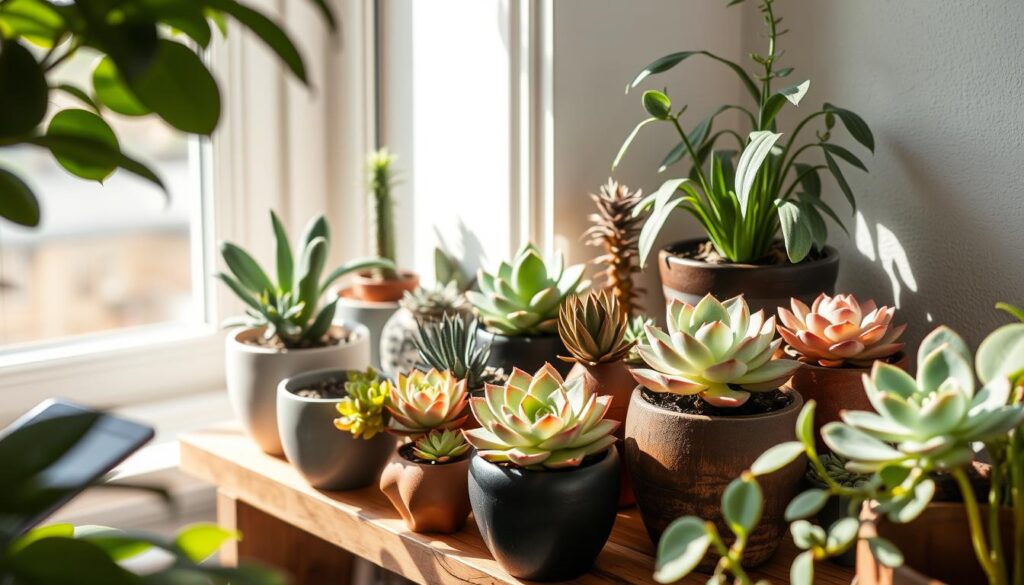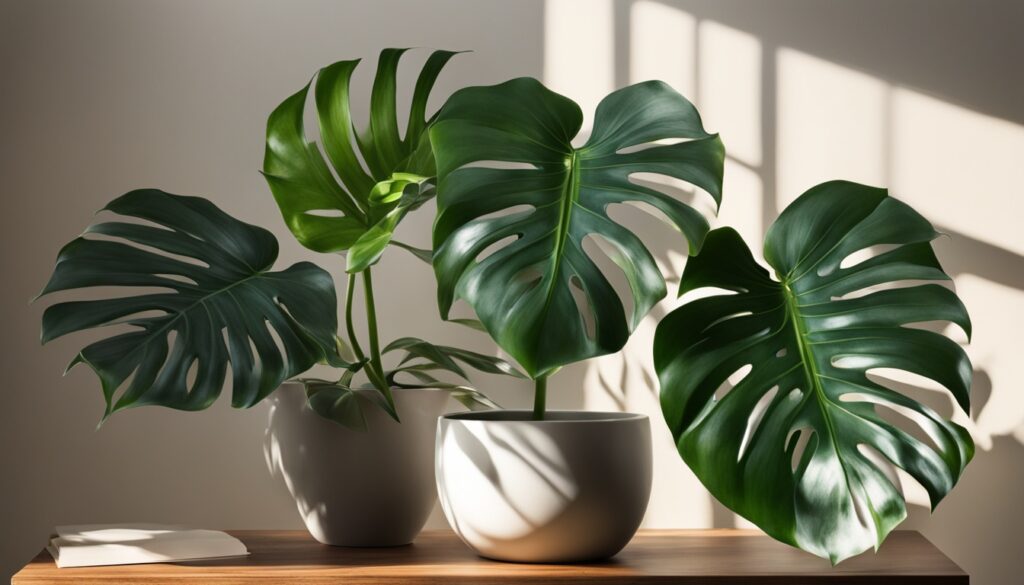Are you drawn to the beauty of Echeveria succulents? These trendy plants are loved by many. They come from semi-desert areas in Central America, Mexico, and northwestern South America. Echeverias do well indoors, showing off their colorful leaves.
But how do you make sure these indoor succulents not just survive but thrive in your home?
Key Takeaways
- Echeveria succulents are versatile, easy-going indoor houseplants that can withstand periods of neglect.
- Proper watering, lighting, and soil requirements are essential for the long-term health and thriving of Echeveria plants.
- Echeveria plants are responsive to feeding and can be easily propagated through offsets or leaf cuttings.
- Placement in a sunny window and temperature control are crucial for Echeveria’s growth and preventing issues like root rot.
- Echeveria care involves a balance of daily maintenance and seasonal adjustments to ensure these beautiful succulents thrive indoors.
Introduction to Echeveria: The Trendy Indoor Succulent
Echeveria is a popular indoor succulent from the Crassulaceae family. It’s often confused with Sempervivum but has its own charm. With many varieties, it can grow well in different places.
Understanding Echeveria Origins
Echeveria comes from southwest Texas and South America’s mountains. There are over 150 types grown today. These plants are tough and easy to care for.
Common Varieties for Indoor Growing
- Echeveria Afterglow
- Echeveria agavoides
- Echeveria Alta May
- Echeveria Andromeda
- Echeveria pulvinata
- Echeveria subrigida
- Echeveria Topsy Turvy
- Echeveria Baron Bold
- Echeveria Candy Wright
Why Choose Echeveria as Houseplants
Echeveria is great for beginners and those with little time to care for plants. They can handle different light levels, from bright to moderate. This makes them a favorite among indoor plant lovers.
“Echeveria’s unique rosette shape and vibrant colors add a touch of elegance to any indoor space.”
Essential Light Requirements for Indoor Growth
Echeverias are known for their vibrant, architectural foliage. They are a popular choice for indoor succulent enthusiasts. To thrive indoors, these plants need specific echeveria light requirements. The right indoor succulent lighting is key for their rich colors and compact growth.
Echeverias need 6-8 hours of bright, indirect sunlight daily. Window ledges with southern or western exposure are perfect. They offer the right balance of light intensity and duration. While they can handle some direct sunlight, too much can damage their leaves. So, it’s important to watch their light exposure.
If natural light is scarce, grow lights for echeveria can be a big help. LED grow lights and full-spectrum lights are good choices. They mimic the sun’s rays and give the plants the light they need. Place the grow light 12-24 inches above the plant and keep it on for 12-16 hours a day for the best results.
| Light Requirement | Ideal Lighting Solution |
|---|---|
| 6-8 hours of bright, indirect sunlight daily | South or west-facing window |
| Supplemental lighting if natural light is lacking | LED grow lights or full-spectrum lights |
Meeting the echeveria light requirements is crucial for their health. It helps keep their signature rosette shape, vibrant colors, and overall health. By giving them the right indoor lighting, your echeveria will thrive and add beauty to your space.
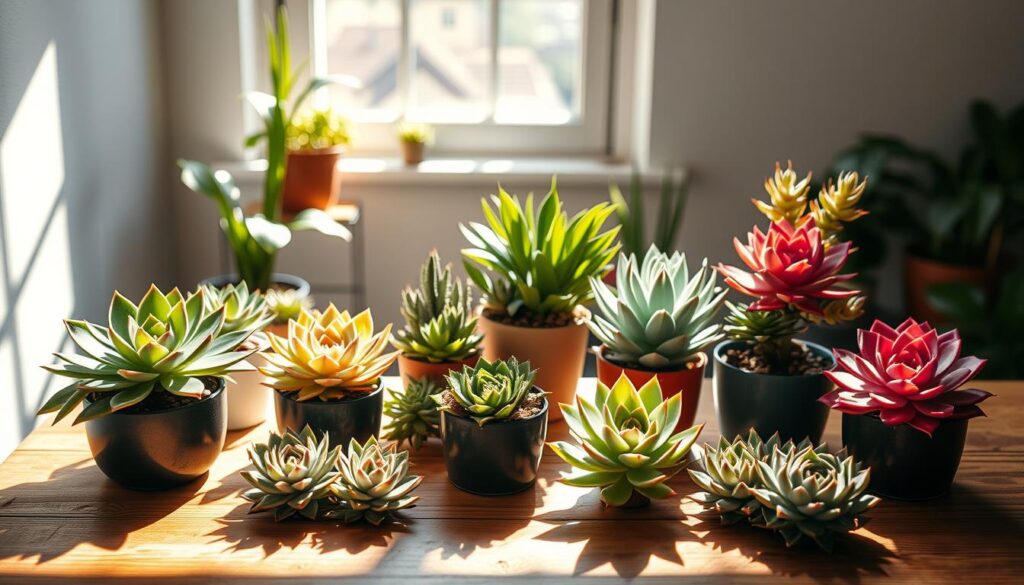
“Echeverias are true light-lovers, and meeting their lighting needs is key to their long-term success as indoor plants.”
Proper Watering Techniques for Indoor Echeveria
Getting the watering right is key for indoor echeveria succulents to grow well. They do best with a “soak and dry” method. This means letting the soil dry out fully before watering again. Too much water is the biggest danger, causing root rot and other problems.
Signs of Overwatering
Signs of too much water include mushy, discolored leaves and stem rot. Leaves might look pale, translucent, or start falling off. If not fixed, this can kill your echeveria.
Signs of Underwatering
Underwatered echeverias have shriveled, wrinkled leaves. They lose their plump look and color. If the soil stays too dry, the plant gets stressed and stops growing.
Seasonal Watering Schedule
- In spring and summer, water deeply but not often. Let the soil dry out fully between waterings.
- In fall and winter, water less and less. This helps prevent too much water during the plant’s rest.
- Let tap water sit overnight before watering. This removes chlorine and fluoride that can harm your plant.
Stick to a seasonal watering plan and watch your echeveria closely. This way, you’ll meet your indoor echeveria watering needs and help it flourish.
Creating the Perfect Indoor Soil Mix
To make sure your indoor Echeveria plants thrive, they need a well-draining soil mix. Echeverias come from semi-desert areas and need soil that feels like their home. A good mix is one part potting soil, one part perlite, and one part coarse sand or gravel.
This mix is light, airy, and drains well. It’s key to stop root rot and other problems from too much water. You can also use a commercial cactus or succulent potting mix. It’s made just for these plants that don’t like too much water.
Good soil is key for your Echeveria’s health and looks. Well-draining soil keeps their rosette shape looking great. It also stops them from getting too tall or droopy from too much water.
| Soil Component | Ratio | Purpose |
|---|---|---|
| Potting Soil | 1 part | Provides nutrient-rich base for plant growth |
| Perlite | 1 part | Improves soil aeration and drainage |
| Coarse Sand or Gravel | 1 part | Enhances soil structure and drainage |
With the right indoor soil mix, your Echeveria plants will stay healthy and look amazing. You’ll get to enjoy their beautiful rosettes for many years.
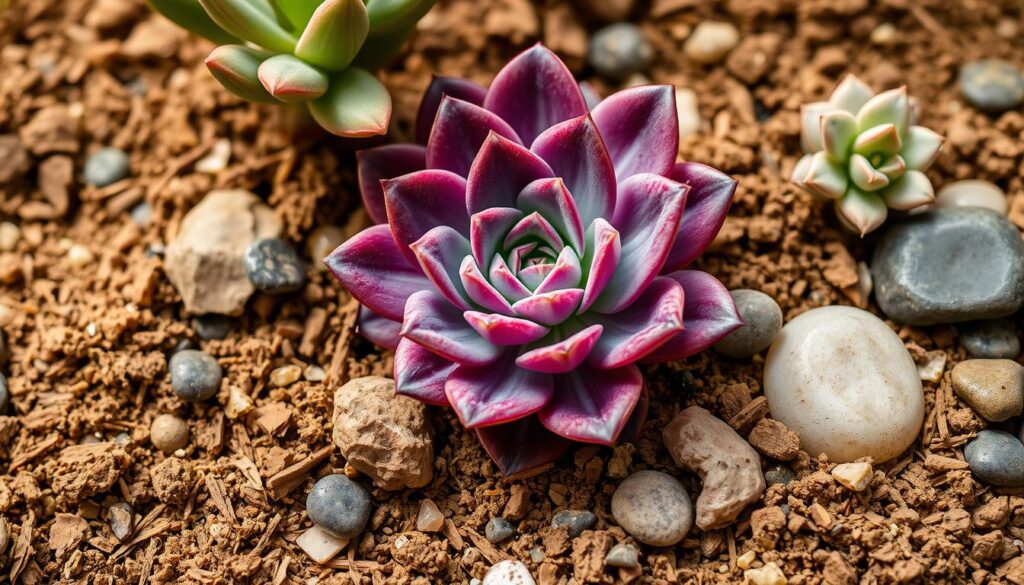
Temperature and Humidity Needs
Echeveria plants are trendy indoor succulents that love warm temperatures but can’t handle cold. They do well in USDA zones 8-11. Indoor plants need to stay above 5°C (41°F) to avoid damage. These plants prefer dry air, but not too steamy places like bathrooms or kitchens.
Optimal Temperature Range
Echeveria plants come from warm climates and do best in temperatures between 65°F to 76°F (18°C to 25°C). Keep them away from cold temperatures below 40°F (4°C) to prevent damage.
Managing Indoor Humidity
Echeverias like dry air and can handle the dryness near heating vents. They do best in humidity levels between 30% and 50%. Avoid bathrooms and kitchens to prevent rot and disease.
Knowing the temperature and humidity needs of echeveria plants helps them thrive in your home.
“Echeverias are hardy succulents that can thrive in dry, warm conditions, making them an excellent choice for indoor gardening.”
Container Selection and Drainage Requirements
When growing echeveria indoors, picking the right container is key. They do well in shallow, wide pots, not deep, narrow ones. This is because their roots are small and they like a tight space.
Unglazed clay pots are great for echeveria. They let water evaporate, keeping the soil dry. Make sure the pot has holes for drainage. Echeverias can get root rot if their roots stay wet too long.
Echeverias don’t need to be repotted often because they grow slowly. When you do repot, pick a pot only a bit bigger. This helps keep the soil just right and encourages healthy growth.
Succulent Containers and Drainage
- Unglazed clay or terracotta pots are ideal for echeveria, as they allow for optimal soil drying and air circulation.
- Ensure the container has ample drainage holes to prevent waterlogging and root rot.
- Choose a pot that is only slightly larger than the current one to avoid overwatering issues.
- Echeverias do not require frequent repotting, as they have a slow growth rate and small root systems.
| Container Material | Drainage Requirement | Repotting Frequency |
|---|---|---|
| Unglazed clay or terracotta | Ample drainage holes | Every 2-3 years |
| Plastic or glazed ceramic | Mandatory drainage holes | Every 1-2 years |
| Wooden or metal | Crucial drainage holes | Every 1-2 years |
By following the echeveria repotting guide, choosing the right succulent containers, and ensuring proper drainage for indoor succulents, you can help your echeveria thrive indoors.
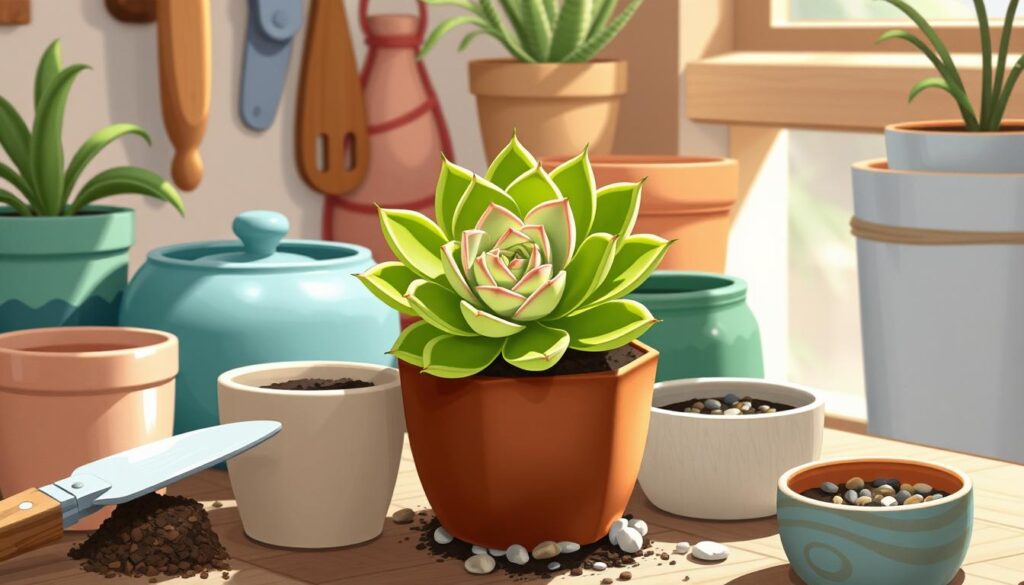
Echeveria Care Indoors: Best Practices and Tips
To keep your echeveria plant thriving indoors, follow a daily care routine and make seasonal changes. Knowing what these succulents need helps keep them healthy and looking great.
Daily Care Routine
For successful echeveria care indoors, watch the light and check for pests or diseases. Give your echeveria 6-8 hours of bright, indirect light each day. This can be from a south or west window or a grow light with 20-40 watts.
Look over the leaves and stems for damage or pests like mealybugs, aphids, or spider mites. If you find any, use neem oil or insecticidal soap to keep your indoor succulent maintenance on track.
Seasonal Maintenance
As seasons change, so does your echeveria care indoors routine. In spring and summer, water more often, every 2-3 weeks. Also, use a balanced, diluted fertilizer every 4-6 weeks.
- Adjust watering based on temperature and humidity changes.
- Keep your echeveria away from cold drafts and sudden temperature changes in winter.
- Remove dead or damaged leaves to avoid pests and keep the plant looking neat.
- Rotate the pot to ensure even seasonal care for echeveria and sun exposure.
By sticking to these echeveria care indoors tips, you can enjoy these beautiful, easy-to-care-for succulents all year.
Feeding and Fertilization Schedule
Echeveria, like many succulents, need only a little food. But the right fertilizing echeveria can help them grow strong and colorful. It’s important not to overdo it, as too much fertilizer can harm them.
For your indoor succulent fertilizer, choose a balanced liquid fertilizer or a succulent plant food. Use it once a month or every other month when they’re growing fast, usually in spring and summer.
- Make sure not to spray fertilizer on the leaves to avoid burning.
- Stop fertilizing in winter when they grow slower. Wait until they start growing again.
With a gentle, regular feeding plan, your Echeveria plants will get the nutrients they need. This will help them have strong roots, beautiful leaves, and plenty of flowers.
| Fertilizer Type | NPK Ratio | Application Frequency | Dilution Rate |
|---|---|---|---|
| Balanced Liquid Houseplant Fertilizer | 10-10-10 | Monthly or Every Other Month | 1/2 Strength |
| Specialized Succulent/Cactus Fertilizer | 6-12-6 | Monthly or Every Other Month | 1/4 to 1/2 Strength |
Knowing how to fertilize Echeveria right can make them thrive. This way, they’ll keep your home looking beautiful.
Propagation Methods for Indoor Echeveria
Echeverias are versatile succulents that can be easily grown. You can use two main methods: leaf propagation and offset division. These techniques help you grow more echeverias indoors or share them with others.
Leaf Propagation Technique
To propagate echeverias by leaves, remove healthy leaves from the mother plant. This method takes about 3-4 weeks for roots to form. Start by carefully plucking a mature leaf from the echeveria.
Let the leaf sit for 24 hours to form a callus. Then, place it in succulent soil that drains well. Keep the soil moist but not too wet. Soon, a new rosette and roots will appear.
Offset Division Process
Echeverias produce offsets, or “pups,” at the base. These small rosettes can be separated and replanted. Wait until the offsets are big enough, then twist or cut them off from the mother plant.
Make sure each offset has its own roots. Plant them in a potting mix that drains well. They will grow into strong, independent echeverias.
These echeveria propagation techniques make it easy to grow more indoor echeverias. You can choose leaf propagation or offset division. Both methods are great for succulent leaf propagation and propagating echeveria offsets. Soon, you’ll have a beautiful collection of these stunning plants in your home.
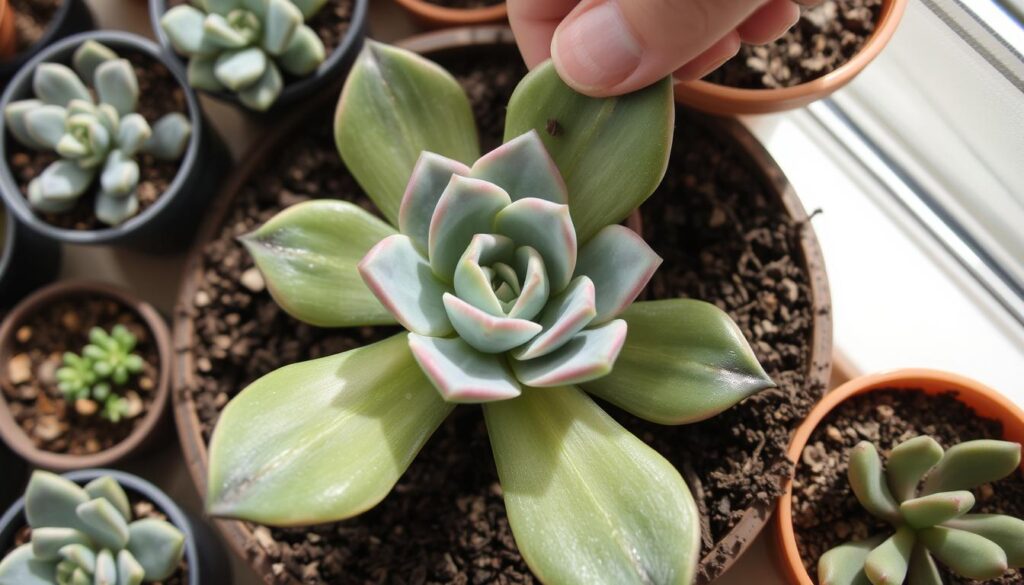
“Propagating echeverias is a rewarding and cost-effective way to expand your succulent garden. With a little patience and the right techniques, you can create a thriving collection of these stunning indoor plants.”
Common Problems and Troubleshooting
Echeveria succulents can face a few common challenges. One big issue is overwatering. This can cause yellowing, mushy leaves and stems, and even root rot. It’s important to let the soil dry completely between waterings and not keep the roots wet all the time.
Not enough light exposure can also cause problems. It can make the plants grow lanky and pale as they stretch for more sunlight. Echeverias do best in bright, indirect light and might need grow lights indoors.
Pests like mealybugs, aphids, and spider mites can be a problem for indoor Echeverias. Look for cottony masses on stems and leaf veins. Use rubbing alcohol or insecticidal soap to treat these pests quickly.
Echeverias can also get sun damage if they suddenly get too much direct sunlight. This can cause brown or tan patches on the leaves. To avoid this, slowly get the plants used to brighter light.
- Prevent root rot by ensuring proper drainage and avoiding overwatering.
- Increase light exposure or use grow lights to combat leggy echeveria growth.
- Treat pests like mealybugs and spider mites with rubbing alcohol or insecticidal soap.
- Gradually acclimate echeveria plants to prevent sun damage from sudden light changes.
By tackling these common problems and following best practices for echeveria pest control and succulent diseases, you can keep your indoor Echeveria plants healthy and colorful.
Indoor Location Selection
Choosing the right spot for your indoor echeveria is key for its growth. These plants love bright, indirect light and specific conditions to do well indoors. Their stunning rosette-shaped leaves are a sight to behold.
Best Rooms for Placement
South or west-facing windowsills, sunrooms, and spots near grow lights are perfect for echeveria. These areas give them the bright, indirect light they need. This helps them stay vibrant and healthy.
Avoiding Problem Areas
Stay away from dark corners, air conditioning vents, and humid places like kitchens and bathrooms. These spots can cause problems like etiolation, pests, and diseases. Echeveria do best in well-ventilated areas with moderate humidity.
When picking a spot for your echeveria, make sure it has good light and air. Also, keep it away from extreme temperatures and drafts. The right spot will help your echeveria thrive and look amazing indoors.
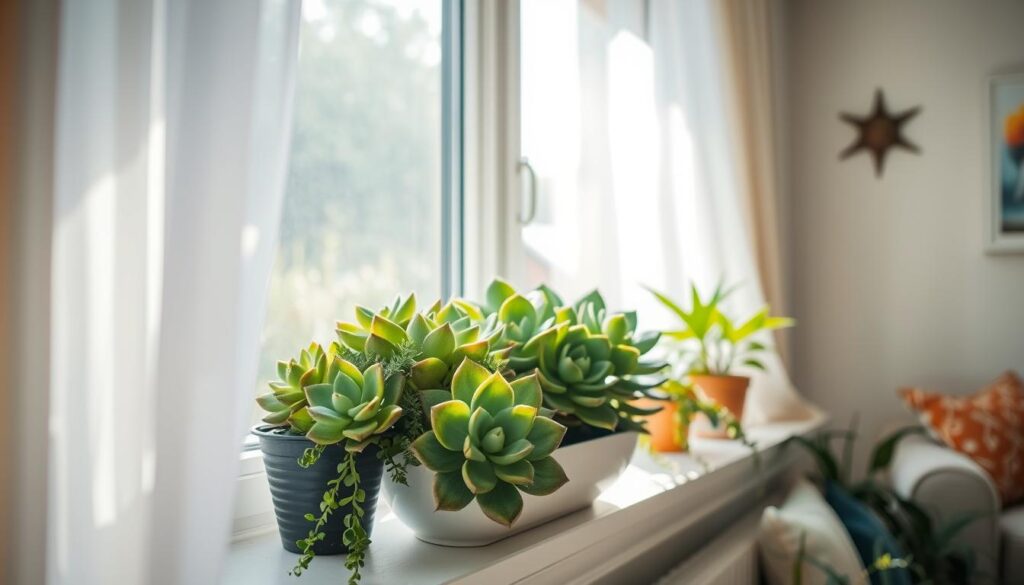
| Optimal Conditions for Echeveria | Conditions to Avoid |
|---|---|
|
|
By choosing the best spots for your echeveria, you ensure they thrive. These low-maintenance succulents add beauty to your home. With the right care, they’ll look stunning and vibrant.
Pruning and Maintenance Tips
Echeverias don’t need a lot of pruning. But, regular succulent maintenance makes them look better and stay healthy. To care for your echeveria, remove dead or damaged leaves at the base of the rosette.
If your echeveria gets too long, cut the top off with a sharp knife. Let the cut heal, then replant it. This helps it grow new, compact leaves.
Also, clean your echeveria’s leaves often. Use a soft brush to remove dust. Check for pests while you’re at it. This simple care keeps your echeveria looking great and growing well.
Echeverias are easy to care for, but a bit of pruning and cleaning helps a lot. With the right care, your echeveria will be a happy indoor plant for many years.
